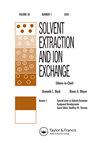ALSEP过程的表征:研究洗涤阶段的平衡和中间配合物
IF 2.1
4区 化学
Q3 CHEMISTRY, MULTIDISCIPLINARY
引用次数: 1
摘要
摘要:采用实时和传统光学光谱、离线化学分析和平衡溶剂萃取测量相结合的方法,监测锕系元素-镧系元素分离(ALSEP)溶剂萃取工艺的双相磨擦阶段钕或镅有机相配合物形态的逐渐变化。与其他研究人员的发现一致,通过三种不同的多变量分析方法确定了四种独特的有机相物种。有机相最初含有M(TEHDGA)2(HEH[EHP])2(NO3)3配合物。当ALSEP有机相用丙二酸水溶液缓冲液洗涤时,配合物失去HNO3形成M(TEHDGA)2(H(EH[EHP])2)(NO3)2作为第一有机相中间物。与洗涤水相进一步接触形成第二个中间物质M(TEHDGA)(H(EH[EHP])2)2(NO3),最终形成只含有HEH[EHP], M{H(EH[EHP])2}3的配合物(其中TEHDGA = N,N,N ',N ' -四(2-乙基己基)二乙醇酰胺和HEH[EHP] = 2-乙基己基膦酸单-2-乙基己基酯)。当使用较低浓度的硝酸(例如0.5 M HNO3)提取锕系元素或镧系元素时,在平衡ALSEP有机相中也观察到类似的中间物质。本文章由计算机程序翻译,如有差异,请以英文原文为准。
Characterization of the ALSEP Process: Investigating Equilibrium and Intermediate Complexes of the Scrub Stage
ABSTRACT A unique combination of real-time and conventional optical spectroscopy, off-line chemical analyses, and equilibrium solvent extraction measurements were employed to monitor progressive changes in the speciation of the organic-phase complexes of neodymium or americium in the biphasic scrub stage of the Actinide-Lanthanide Separation (ALSEP) solvent extraction process proposed for trivalent actinide/lanthanide separations. Consistent with the findings of other researchers, four unique organic-phase species are identified by three separate methods of multivariate analysis. The organic phase initially contains M(TEHDGA)2(HEH[EHP])2(NO3)3 complexes. As the ALSEP organic phase is scrubbed with an aqueous malonate buffer, the complex loses HNO3 to form M(TEHDGA)2(H(EH[EHP])2)(NO3)2 as the first organic-phase intermediate species. Further contact with the scrub aqueous phase forms a second intermediate species, M(TEHDGA)(H(EH[EHP])2)2(NO3), and eventually a complex containing only HEH[EHP], M{H(EH[EHP])2}3 (where TEHDGA = N,N,N’,N’-tetra(2-ethylhexyl)diglycolamide and HEH[EHP] = 2-ethylhexyl phosphonic acid mono-2-ethylhexyl ester). Similar intermediate species were also observed in equilibrium ALSEP organic phases when lower aqueous concentrations of nitric acid (e.g., 0.5 M HNO3) were used to extract actinides or lanthanides.
求助全文
通过发布文献求助,成功后即可免费获取论文全文。
去求助
来源期刊
CiteScore
4.40
自引率
5.00%
发文量
15
审稿时长
8.4 months
期刊介绍:
Solvent Extraction and Ion Exchange is an international journal that publishes original research papers, reviews, and notes that address all aspects of solvent extraction, ion exchange, and closely related methods involving, for example, liquid membranes, extraction chromatography, supercritical fluids, ionic liquids, microfluidics, and adsorption. We welcome submissions that look at: The underlying principles in solvent extraction and ion exchange; Solvent extraction and ion exchange process development; New materials or reagents, their syntheses and properties; Computational methods of molecular design and simulation; Advances in equipment, fluid dynamics, and engineering; Interfacial phenomena, kinetics, and coalescence; Spectroscopic and diffraction analysis of structure and dynamics; Host-guest chemistry, ion receptors, and molecular recognition.

 求助内容:
求助内容: 应助结果提醒方式:
应助结果提醒方式:


